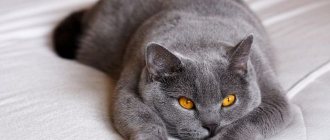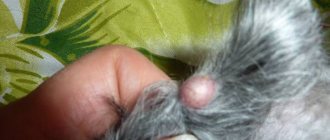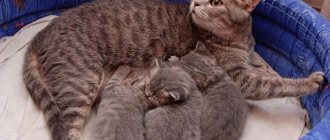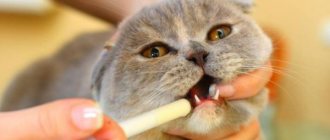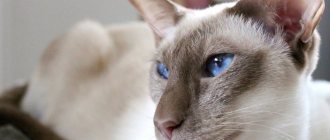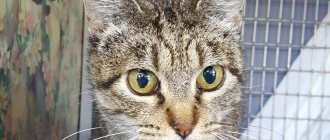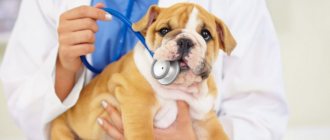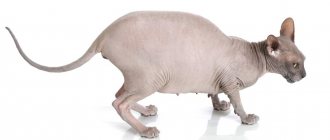Pregnancy
Fluffy beauties go pot-bellied for about sixty days, but this is an average period. It happens that kittens appear on the fifty-eighth or seventy-first day. The beginning of this period is the day of mating plus thirty-six hours. Take care of your pet during this period, follow the following rules:
- do not let her jump from a great height, she may fall and get hurt, in addition, such situations are fraught with miscarriage,
- try to isolate her from other pets and children so that she is not picked up and injured again,
- make sure there are no drafts in the house, protect her from stress,
- create a high-calorie menu,
- do not give antibiotics and other medications without the recommendation of a veterinarian,
- do not use anthelmintics or painkillers.
If you follow these recommendations, at the appointed time your pet will bring you several fluffy balls that will be healthy and strong. It is quite difficult to immediately determine what she suffered; there are no tests for this. But there are signs that can indirectly indicate whether conception has occurred or not. This:
- weakness, possible nausea,
- decreased activity, lethargy,
- change in appetite in any direction,
- pink nipples after twenty-one days,
- change of taste,
- changes in habits, most often the animal becomes more affectionate and intrusive,
- increased gas exchange,
- weight gain,
- more frequent and deeper breathing (at the end of the period).
An ultrasound will help you understand whether you can expect a replenishment in the near future, already from the second week after the act. X-rays will show the result only after forty days, this will help identify pathologies. The veterinarian will tell you the result on the twentieth day, but later you can no longer palpate until the forty-ninth day, because there will be fluid in the uterus. The abdomen will appear in the fifth or sixth week, and in the seventh the babies will begin to move.
Feeding your pet should become more nutritious and of better quality. Buy special super-premium food and increase the feeding rate by fifty percent from the third week, and from the eighth week you should not overfeed it. Giving food three to five times a day
It is important that the expectant mother receives the necessary supply of fat, otherwise she may not have milk. Make sure you are not obese - in this case, childbirth can be difficult and miscarriages may occur.
How long does labor take?
A cat can give birth for twelve to eighteen hours. If longer, this is a pathology and you need to call a veterinarian. In addition, if the firstborn has already emerged, but no one else has emerged during this time, then this is a problem. If two days have passed, then the kittens most likely died in the womb, and surgery is necessary. It is advisable to take an x-ray in advance to find out how many offspring to expect.
When it all started, you need to provide the cat with peace and a dark place, keep water nearby, talk affectionately and not leave him alone. You can tell that day X is close by the fact that the fetus is moving - this happens in about two weeks. The woman in labor begins to look for a place, becomes very restless within a week, licks her stomach, climbs into closets and rummages through clothes. She may go to the toilet frequently.
You need to show her a prepared place, a box or a house, so that she can sleep there and calm down. If she doesn’t like it there and decides to choose another place, you shouldn’t forcibly move her back - this is extra stress. Once the kittens are outside, move the family there.
When you realize that your pet is about to give birth, prepare the items you need to stock up on in advance. This is a durable box in which the kittens will not blow, clean towels - paper and rag, sterile gloves from the pharmacy that you will wear all the time, an antiseptic, a pipette that can be used to pump out fluid from the nose, thread, scissors.
We can distinguish separate stages of action:
- The first is when contractions and pushing begin, at which time the kitten passes through the tubes. Colorless discharge appears, breathing becomes heavy, and wheezing may occur. This means that the stage is coming to an end and moving on to the next one.
- The second is the very appearance of children. At this stage, it is not uncommon for the water to break first and then the head to protrude. If another part of the body appears, you need to help the fetus come out, and if that doesn’t work, call a veterinarian. After the rupture of the amniotic sac, it may take two hours, but no more, until everything starts. When the baby is born, the mother gnaws the umbilical cord. If she doesn't, use scissors and carefully cut it, then treat the wound with antiseptic. The baby should be removed from the shell, if necessary, wiped with a clean cloth and special attention should be paid to freeing the mouth and nose from mucus.
- The uterus calms down and an afterbirth comes out, which the cat can often eat. This replenishes her strength, but you shouldn’t give more than two to avoid stomach upset. After ten minutes of calm have passed, labor continues.
Be sure to count the afterbirths; if there are fewer of them than the kittens, you need to see a doctor - this may cause inflammation. Sometimes the process can be interrupted for twelve to thirty-six hours, when several small lumps have already appeared. But consultation with a specialist is necessary - additional stimulation may be required.
If a kitty has given birth to offspring for the first time, then usually there can be from one to three children. Then the number will increase, on average six to eight fluffies.
Pregnancy and childbirth of a cat
Estrus and mating time for cats occurs in February, March and the end of August. So this can happen twice a year. However, if the cat is not fertilized during estrus, estrus may repeat after 2–3 weeks.
Cats become sexually mature much earlier than males; this happens at 6–8 months of age (in males, sexual maturity occurs at 8–10 months). Unlike cats, whose desire to mate is constant, a cat is limited in time. She is in heat for about a week. The ability to reproduce offspring remains in females until old age, at least up to 8 years.
The onset of estrus is accompanied by changes in the cat's behavior. The animal meows loudly, the meowing turns into a piercing loud howl and squeal. The cat can roll on the floor, arch, its movements resemble those of a snake. She rubs her head and muzzle on the floor.
A cat and a male cat ready to mate recognize each other by smell a few days before the onset of estrus. During cat weddings, along with the urine, a special substance is released from the anus of cats and cats - a secret, it has a strong specific smell. They find each other by this smell.
Fertilization of a cat occurs in three stages - preparation of the egg, entry of sperm into the cat's body and penetration of sperm into the egg.
Each fetus in a cat is contained in its own amniotic sac. After a month of pregnancy, the embryos reach the size of a pigeon egg, and by the 45th - 47th day their length is 5 - 8 centimeters. The entire pregnancy period lasts 58–65 days. After which childbirth occurs. As a rule, several kittens are born, from two to four.
General information about the duration of gestation
On average, the question “how long does a cat stay pregnant?” The most frequently heard answer is 2 months. However, this is a rather loose concept - some individuals barely carry their offspring to term for up to 60 days, and for some the process can last up to 70.
According to general estimates, the minimum gestation period for cats is from 56 to 60 days, the maximum normal is considered to be 71 days (some sources give 72 days). These are periods when the birth of viable offspring is allowed. Most often - 64-67 days (roughly rounded, it comes out to 9 weeks).
The entire “pregnant” period is conventionally divided into 3 phases of development, each of which on average includes 3 weeks.
1 phase
This period lasts from the moment of expected conception to 21 days. During this period, eggs are fertilized and embryos develop. By the 15th day, the embryo already becomes up to 1 cm in size, by the 18th day the paws appear, and by the end of the period the internal organs are already formed. It is in this phase that active pinking of the nipples is observed.
2 phase
During this period (from 22 to 42 days), the brain, skeletal structure, muscles and endocrine system are actively formed and developed. From this point on, the kittens are called fetuses, taking on the classic feline appearance with a clearly defined muzzle and genitals. Only after a month of pregnancy the cat’s belly begins to grow a little.
3 phase
On days 43-63 from the moment of conception, kittens, growing to 8-10 cm, acquire a tail and acquire a coat with a certain color. By the middle of the period, their size reaches 13 cm, by the 57th day they are already fully formed and developed babies who are ready to be born at any moment. The maximum size of a newborn depends on the constitution of its parents.
There are exceptions to all rules. The duration may vary depending on many factors:
- offspring of purebred individuals born before 60 days are most often non-viable;
- cats with a slender constitution (subtle) usually never go pregnant longer than 65 days (on average it is 60-65 days), and fat and well-fed ones usually carry a pregnancy and the period can reach 70-72 days;
- primiparous cats, especially those who become pregnant during their first heat before the age of 1 year, in most cases give birth earlier than the expected average period (up to 60 days). Kittens are not always born viable and are often weak and small. That is why experienced breeders do not recommend mating a cat to produce offspring in the first heat and under the age of one year;
- primiparous middle-aged cats bear their offspring somewhat longer than their female peers who have given birth;
- yard outbred cats bear less fruit than domestic and special breed cats. Sometimes healthy babies are born on the 55th day - this indicates better endurance and higher adaptability of street individuals compared to domestic ones;
- in a fold cat (British, Scottish), kittens are gestated for an average of 63-67 days, but almost never less than 60 days;
- cases of nursing up to 75 days have been recorded. The course of the entire period was without complications, and the newborns were all alive and well. The reasons for such a long but safe gestation are still a mystery to veterinarians;
- Pregnancy of the Maine Coon breed is usually longer than that of other breeds - up to 68 days or 9 full weeks + preparation for the birth of the cat herself;
- long-haired cats stay pregnant longer (up to 70 days) than smooth-haired or completely hairless cats (around 65 days);
- the fewer fruits there are in the litter, the longer the cat can go pregnant and, conversely, the more, the faster and more often the birth will occur before the due date;
- weather conditions affect the onset of labor - sudden changes in temperature and environmental humidity can suddenly trigger premature birth;
- The pregnancy of a Scottish cat is usually shorter than that of a British cat, in which the pregnancy period can sometimes increase to 70-72 days. Therefore, there is no clear answer to the questions of how long pregnancy lasts in a Scottish cat or how long pregnancy lasts in a British cat - variations in duration are present here too.
Recommended Products
The diet largely depends on age and personal eating preferences. But regardless of this, a Scottish woman should consume the following types of foods.
Squirrels. They should be an essential component of nutrition, as they ensure the development of all types of tissues and muscles. Proteins of plant and animal origin must be present in the diet. It is necessary to give your favorite lop dog lean turkey, beef or chicken every day.
Fermented milk products such as kefir, cottage cheese, fermented baked milk and yogurt improve digestion and provide the body with calcium. It is an important component in the formation and strengthening of the skeletal system, teeth and claws.
Such products can be given in small quantities, and preferably low-fat or with a small percentage of fat.
Vegetables. Almost all types of vegetables will be well digested and absorbed in the pet’s body. The exception is white cabbage, which causes fermentation and stagnation in the stomach.
Vegetables should only be served boiled. They can also be grated and added to meat.
Cereals. Oatmeal is best. It improves digestion and stimulates intestinal function. Rice can cause constipation. Therefore, it is better to focus on the preferences of the cat itself.
Fish. During pregnancy, it is better to exclude it from the diet. But you can give small amounts of salmon, trout, mackerel or sardine meat, which contains fat-soluble vitamins.
If a Scottish woman prefers to eat ready-made food, then the best of them will be premium or super-premium class, created specifically for pregnant women.
Cheap food will not do any good. Due to the insufficient content of vitamins and minerals in it, her health may deteriorate.
Industrial food for a pregnant cat
Dry food for pregnant cats and kittens is balanced in composition and easy to use. All you need to do is open the bag of food and pour it into a bowl. The package usually contains the daily diet for a cat, and manufacturers often give measuring cups when purchasing a cat. I never read such recommendations, much less measure food in cups or grams. My cats have free access to dry food; they eat as much as their body requires. There is no need to be afraid that a pregnant cat will overeat unless she has health problems.
1. Royal Canin is a leading manufacturer of premium food and is most widely represented in Russia. Royal Canin has two types of food suitable for pregnant cats
Queen Royal Canin meets the basic needs of cats during pregnancy. It contains a unique complex of nutrients. such as beta-carotene, EPA/DHA, arachidonic acid, folic acid, taurine, contains a complex of antioxidants with a synergistic effect (vitamins E and C, taurine, lutein).
Queen Royal Canin food is specially designed for pregnant cats, contains an optimal percentage of fat, which allows you to provide the expectant mother with energy, and at the same time is not too high in calories. The cracks contain fatty acids, which promote the onset of lactation and improve the quality and quantity of milk.
As practice shows, not all cats willingly eat Queen Royal Canin. If your pet is one of these, choose
This food is intended for kittens from 1 to 4 months, and is also ideal for a pregnant or lactating cat. Usually mother cats eat it with pleasure, because... The croquette is small in size and has a soft texture.
From Royal Canin wet food, a pregnant cat can be fed kitten spiders.
COMPOUND:
INGREDIENTS
Meat and animal derivatives, cereals, vegetable protein extract, plant derivatives, minerals, oils and fats, yeast, various sugars.
SUPPLEMENTS (PER 1 KG)
Nutritional supplements: Vitamin D3: 175 IU, E1 (Iron): 4 mg, E2 (Iodine): 0.36 mg, E4 (Copper): 2.8 mg, E5 (Manganese): 1, 3 mg, E6 (Zinc): 13 mg.
NUTRIENT CONTENT
Protein: 12% Fat: 4% Minerals: 1.8% Fiber: 0.9%
I have not seen any specially formulated food for pregnant cats from other manufacturers. If your cat eats a different brand of food, of course, you should not switch it to Royal Canin. Buy kitten food.
I feed my cats Monge Kitten food. Although often under their pressure, when they start to act up, I return to Royal Canin Royal Canin Mother & Babycat, they eat it very willingly.
The product contains a lot of high-quality easily digestible protein, a vitamin-mineral complex and probiotics for strong immunity. The food is also suitable for feeding pregnant and lactating cats.
COMPOUND:
Chicken (10% fresh, 26% dehydrated), rice, animal fat (99.6% chicken fat, preserved with natural antioxidants), corn, hydrolyzed animal protein, dried beet pulp, corn gluten meal, powdered egg (high complete protein), fish (dehydrated salmon), fish oil (salmon oil), brewer's yeast (source of MOS and Vitamin B 12), insoluble pea fiber, taurine, XOS (xylooligosaccharides 3 g/kg), hydrolyzed yeast (MOS), yucca Schidigera, wild rose.
Wet food from other brands that I feed my pregnant cats.
Animonda food for kittens vom Feinsten
Why do I like Animonda food? Animonda is a premium wet food produced in Germany. According to the manufacturer, these foods:
made from selected raw meats with the addition of seafood, vegetables and fruits;
they do not contain flavorings, flavor enhancers or soy proteins; fully balanced with vitamins and minerals;
have good quality at an affordable price;
Signs of pregnancy
Unfortunately, science has not yet come up with pregnancy tests for animals. And an ultrasound will help determine the due date only after a couple of weeks. The duration of pregnancy of a Scottish Fold cat and future births can be determined at home. But first, let’s answer the question: how long does a pregnant Scottish cat walk?
The average gestation period for kittens is 60-62 days. Of course, in real life there may be slight deviations of a few days. In addition, it is not a fact that after the first mating the animal will become pregnant. Several meetings may be required. One way or another, the first signs of pregnancy can only be determined after 21 days after a successful mating.
ATTENTION! Often a situation arises when, after 2-3 weeks after mating, the cat does not show any signs of pregnancy. For example, behavioral changes (lethargy) or morning sickness
There is no reason to worry, but if you wish, you can consult a doctor. Let’s note some signs of pregnancy that will help determine an “interesting” situation:
- the pet’s belly is rounded, and the cat itself gains weight;
- nipples swell and turn pink;
- character changes sharply, activity decreases, drowsiness appears;
- the cat refuses its favorite food and prefers foods that are unusual for it;
- The cat's sleep lasts longer, she tries to find quieter and more secluded places.
How long do pregnant Scottish women walk?
It is very important to know how long pregnancy lasts in Scottish cats. After all, complications may arise, and you need to be on guard
On average, this period lasts 63-67 days or 9-10 weeks.
In the first 2-3 weeks of pregnancy, the fetus is just beginning to form. Paws appear and internal organs form. It is not yet possible to determine if a cat is pregnant by its appearance.
3-5 weeks - the expectant mother's hormonal levels change, so she may become overly affectionate or aggressive. The belly begins to grow. The cat eats more and tries to find a secluded place. Fetuses develop a brain, skeleton, endocrine system and muscles.
5-7 weeks - the cat becomes inactive and prefers to lie down. The fruits begin to grow hair. They already look like kittens, have all the organs, but are still light in weight.
7-10 weeks - the belly has grown even more. The fruits gain mass during this period. The cat becomes restless, increasingly looking for a secluded place. Sometimes it is near the owner, caressing, following him.
It’s easy to calculate pregnancy by week, the main thing is to know the mating date.
Complications may occur during pregnancy
You should pay attention and contact your veterinarian if:
- the period has exceeded 68 days;
- labor began before the 63rd day;
- the cat is lethargic and has a high fever;
- the animal does not eat for several days in a row;
- any discharge began before the due date.
The cat needs to be fed well, monitor its condition, not allow it to jump from heights, and handle it carefully.
Timing and duration
Now let's look at how long a cat's pregnancy lasts. As a rule, representatives of the Scottish Fold breed can carry offspring for 60 to 65 days.
The length of pregnancy depends on a number of factors:
- Weights. Large animals tend to bear kittens longer than normal, while small animals (up to 3 kg) sometimes give birth prematurely.
- Age. The first pregnancy, especially if the cat is not yet 1 year old, sometimes ends in birth after 50 days. This usually leads to the death of the offspring.
- Number of kittens. The more there are, the shorter the pregnancy will last.
- Health status. Illness and weakness of the animal can cause miscarriage.
Using the cat's pregnancy calendar, make sure that pregnancy does not prolong the pregnancy. If birth has not occurred on days 68–69, you must call a veterinarian.
Postpartum care for your tartan
After giving birth, the Scottish cat needs to be fed in small portions three times a day. You should give light food that is well and quickly absorbed in the stomach. Most cats do not want to leave the house after giving birth, so at first you need to bring her food there. She must eat well so that milk for feeding the kittens is produced faster.
Drinking water should always be available to the animal, as after birth they need fluid more than usual. When a cat stops breastfeeding her babies, she can be returned to the normal diet that she had before pregnancy and childbirth. After her kittens are taken away, the Scotsie should not drink any liquid for the first 24 hours.
A cat's house with kittens still needs to be cleaned periodically. Therefore, it will have to be moved to another place from time to time. If disposable diapers are used as bedding, they must be changed as needed. Instead of a baby diaper, you can use a soft, small blanket.
Each animal has a different temperament, so each cat shows care differently depending on its personality. There are conscientious cats who do not want to leave their babies even for a second. Others may leave the nest for a long time and behave more indifferently. In any case, the animal will care for its kittens from time to time until they are adopted.
After separation from their kittens, some Scottish cats may experience symptoms of depression, as they are very affectionate by temperament. She will lose her appetite for a while and may become aggressive towards her owner. But this does not last long; within a few days the animal’s behavior returns to normal.
How to breed Scottish cats
To understand what day of heat and with whom you can breed a Scottish pet, you need to study the rules of their breeding:
Mating of a Scottish Fold or Straight should take place around the third day of estrus. The knitting process itself takes 2-3 days.
In order for the mating to be successful, it is advisable to prepare a place, a fenced-in space, from where the Scottish Fold cannot escape. This is important if the pets will mate for the first time.
Animals become interested in each other within a couple of days, during which time approximately 10-15 close contacts with the cat can occur.
Ovulation in a female occurs directly during intercourse and its quality, and therefore the likelihood of becoming pregnant, directly depends on the experience and behavior of the cat with whom she was mated.
It is important to remember that you cannot cross a fold-eared cat with a fold-eared cat. The Scottish Fold cat can only be bred with the Scottish Straight breed.
The reason is that the lop ear gene not only causes the ears to droop, but also weakens the cartilage in the body and tail of the animal. Such mating can produce very weak babies.
When to castrate a Scottish Fold cat
Pregnancy is one of the special periods in the life of cats, which begins from the day of immediate mating and ends with childbirth.
It is considered normal if prenatal contractions occur between 63 and 66 days from the start of the fetal birth. Kittens born before day 58 usually do not survive.
If the cat has not given birth after 68 days, the owner should immediately call a veterinarian.
It is not difficult to recognize pregnancy; there is slight weakness in the morning and a decrease in the activity of the animal, in some cases there is nausea and vomiting.
This state lasts 10 days while the body adapts to other living conditions.
After 21 days, secondary signs of expecting offspring appear - the papillae swell and the taste changes.
Food must be saturated with vitamins, minerals and other beneficial substances, following the doctor’s recommendations.
Change of habits
Change of mood on the face
It also happens that a good mood changes dramatically and your beloved pussy becomes disobedient and even aggressive. If such circumstances arise, there is no need to touch her, and if she needs communication again, she will come up on her own.
You should not show the desire to feel your stomach with your hands; inept actions can cause harm and even provoke a miscarriage.
If you are not sure that the cat is healthy, you can contact a veterinary clinic to schedule an ultrasound examination. Starting from day 20, the kitten’s heartbeat can be felt in the womb. An examination by a specialist will only give the owner a good mood that the animal is not sick and therefore does not need therapy.
Morning vomiting at 3 or 4 weeks of pregnancy is caused by stretching of the uterine muscles and hormonal imbalances in the body. All these negative consequences disappear after a few days and the owner should not be particularly wary.
We'll be giving birth soon
If the pregnancy is successful, then in the period from 4 to 5 weeks from conception the embryos will grow significantly, and at week 6 the belly will grow even more, all the free space of the uterus will be filled. It is not surprising that it is at this time that the cat is looking for a secluded place for future children.
During pregnancy, the use of drugs containing chemicals should be completely avoided, but if problems arise, a visit to a specialist is necessary.
In the last week of gestation, the mammary glands swell, and the cat becomes inactive and looks thoughtful.
As a rule, at 7 weeks the kittens begin to move, this can be felt by a light touch of the hand or visually.
When the belly becomes large, it is difficult for the animal to clean itself up after visiting the toilet, so it is important for the owner to wipe around the anus with a piece of sterile bandage or gauze to prevent the penetration of germs
Another interesting fact: it is noted that at 3 or 6 weeks of pregnancy, some cats may go into heat, which, as it turns out, is due to insufficient progesterone production.
And if a cat is nearby at this time, then another fertilization may occur during repeated mating.
General recommendations
Mood swings are not the fault of the cat, but the fault of hormones
During this important period of life, the cat becomes interested in its changeable mood, attitude towards its favorite food, some of them like to rest more, and there are kitties that frolic.
In any case, the owner needs to be attentive and sensitive towards his pet. Affection, understanding and love will only give the cat confidence that everything will be fine.
And when kittens are born, the joy will be several times greater. After all, this is a miracle - small cat children, helpless, cute and, of course, beautiful.
Very often, a furry friend is created without the goal of breeding it. Having reached puberty, cats begin to mark their territory, and to avoid this, they are castrated. The question arises at what age can one be castrated? This should not be delayed.
It is optimal to castrate a Scottish cat at 7-9 months. If the operation is not performed in time, the mature kitten will experience discomfort from the inability to satisfy its natural desires.
No special care is required for your pet after surgery. However, care must be taken to ensure that the cat does not lick the wounds and thereby tear the stitches; this can harm the pet’s health.
Preparation and childbirth
Preparations for the birth of a Scottish cat need to begin in advance. A week before the approximate date, have a preventive examination with a veterinarian and arrange in advance for emergency care in case of need. Create as quiet and calm conditions as possible for your cat. Try to keep other pets away from her and do not allow children to disturb the animal.
You also need to prepare disposable diapers, scissors, alcohol for disinfection, thread, Vaseline and a heating pad in advance.
Childbirth is an exciting and responsible event. Especially if they come prematurely. The owner should have a supply of medicines and instruments for childbirth. Of course, it’s easier to give birth in a clinic, but preparation won’t hurt:
- Scissors with blunt ends for cutting the umbilical cord.
- Medicines for disinfection.
- Diapers for wiping kittens and bedding for cats.
- Enema for clearing the airways of kittens.
It happens that the intervals between kittens are up to half an hour. In most cases, birth takes place quickly, and the intervals between the appearance of kittens are several minutes. The kitten is born 12-14 cm long and weighs up to 60 grams.
IMPORTANT! Responsibility and love on the part of the owners will help the Scottish cat more easily endure such a difficult stage in life as pregnancy.
How to determine the number of cubs
Today, there are three methods by which you can determine how many kittens a pregnant cat gives birth to:
- The genetic method is based on the fertility of the pregnant female's mother. If a mother cat on average gave birth to 5-6 kittens per litter, then her female cubs will also bear 5-6 babies. If a female gave birth to 2-3 kittens, then the future offspring are unlikely to have a larger litter.
- The folk method is based on many years of observation of owners of cats of various breeds. The number of cubs is equal to the difference between the swollen mammary glands of the female during pregnancy minus two. The result is not 100% guaranteed, but in most cases it turns out to be correct
- The scientific method is considered the most accurate of all existing ones and is carried out a week or two before the upcoming birth using ultrasound equipment.
The most accurate method for determining the number of kittens is ultrasound
Important! It is strongly not recommended to palpate the belly of a future mother, as such actions can damage the soft bones of unborn kittens and put the cat in a stressful state.
Helping a newborn kitten
When talking about how a Scottish cat gives birth, one cannot lose sight of the moment of providing assistance to a newly born kitten. Babies are born in a bubble, and if the cat does not immediately begin to care for them, the owner must do everything.
The sequence of actions will be as follows:
- rupture of the bladder at the level of the kitten’s nose;
- removing mucus from the nasal passages using a syringe (the nozzle of the syringe is carefully placed against the nostril and the mucus is sucked out, the procedure is carried out for both nostrils);
- dispersing blood from the umbilical cord with your fingers towards the kitten’s stomach;
- cutting the umbilical cord at a height of 2 cm from the baby’s tummy (you can rub the umbilical cord with your nails);
- Drying the newborn with a clean soft cloth.
Special veterinary training is not required for these manipulations. A healthy kitten begins to squeak and move actively as soon as it is dried.
After giving birth, the cat’s behavior returns to normal, and she begins to take care of the babies, which she was not interested in at the first moment after their appearance, due to a stressful state.
Childbirth among Scots
Let's look at when and how labor begins in a Scottish Fold cat. The first signs of labor in a cat are brownish vaginal discharge.
The behavior of a cat often changes before giving birth: the animal is looking for a place (nest) to give birth, screaming and making attempts, especially if the Scottish female gives birth to kittens for the first time. In such a situation, it is worth staying close to the cat, calming it down and caressing it, and if necessary, helping, delivering the cat’s birth. Kittens are born head first.
Newborn kittens weigh about 100 grams and are a bubble filled with light yellow liquid. After the kittens are born, the mother chews this bladder, releases the cub and licks it to cleanse the lungs. You can help her with this by suctioning the fluid from her nose with an enema while the female gives birth to other kittens.
Kittens come out at intervals that last about 20 minutes, however, the cat can independently increase the duration of labor and delay the appearance of the babies and carry them for another day if something does not suit her or frightens her. After the young mother has been able to give birth to a kitten, the afterbirth comes out.
A Scottish cat will give birth to approximately 2 to 4 kittens the first time, but in general they will give birth to 1 to 8 kittens.
Kittens open their eyes a week after birth. All Scottish kittens are born with straight ears, and only at 3 weeks of age should you pay attention to the ears; in folds, they begin to droop.
Possible complications
In most cases, pregnancy proceeds normally, but if pathologies occur, the animal may need help. The following symptoms indicate the presence of deviations:
- lack of appetite in the pet for more than 24 hours;
- significant increase in body temperature;
- copious discharge from the female genitals with a pungent odor.
Also, a cat may experience premature birth, after which the animal must be shown to a veterinarian. The risk of giving birth to cubs with pathologies is increased in females older than 7 years. Such kittens grow up weak and do not meet breed standards.
Care during pregnancy
A pregnant Scot does not need any special care, but simple rules must be followed. She may need some physical activity to maintain muscle tone.
The cat should be limited in jumping to great heights; special attention should be paid to it in the last months of pregnancy. Due to the shifted center of gravity, the animal becomes clumsy, and unsuccessful jumps are not uncommon
A pregnant Scottish cat should eat well - foods rich in animal proteins (milk and meat) are recommended. To enrich it with vitamins, you can buy super premium dry food for pregnant cats - they are sold in veterinary pharmacies.
In the first stages of pregnancy, you don’t need to change your usual diet. In the third week, it is worth increasing the number of feedings to five times a day. In recent weeks, the Scottish woman's appetite has increased - she will eat three times more than usual. This is the norm, and if an animal demands to be fed, then it must be fed.
To prevent your cat from gaining excess weight, the number of servings should be halved. Excessive obesity during pregnancy is undesirable. Frequent consumption of food in late pregnancy also affects the size of the kittens. They become larger, which can make childbirth difficult. A few days before the final day, the animal’s appetite decreases. This occurs due to a full abdominal cavity.
At this moment, the body needs calories - it is advisable to feed the Scottish breed with small portions of boiled meat; it is also necessary to add boiled fish and boiled eggs to the diet. Dairy products must include cottage cheese and cottage cheese. If you feed her exclusively with natural products, then you should buy special supplements for pregnant cats. During pregnancy, an animal may experience minor intestinal problems, which are most often accompanied by constipation. To prevent this problem, you can add a small amount of any canned fish in oil to your diet.
Nutrition
In the first weeks of pregnancy, the Scottish cat eats as usual. But in the later stages, the pet gradually refuses frequent meals because... kittens grow and take up all the space in the stomach. In this case, you should reduce the diet, but give portions more often 4-5 times a day.
For a pregnant cat, not just a proper diet is important, but also one rich in minerals and vitamins. It would be a good idea to add special vitamin complexes to the bowl, which can be purchased at the pharmacy.
If your cat's diet consists of dry food, it is recommended to gradually add canned food for kittens to the bowl. By the end of pregnancy, the menu should preferably consist of canned food. When eating natural foods, experts recommend including the following foods in your diet:
- boiled meat (about half of the diet);
- boiled vegetables;
- eggs;
- small portions of lean boiled fish (in no case sea fish!)
To improve the functioning of the digestive system, it is recommended to add beet puree to the diet.
To actively produce milk, you can feed your cat a salad of scalded nettle leaves. To facilitate childbirth and prevention, you can give a decoction of raspberry leaves. Twice a day - morning and evening.
Features of the first mating
During the first heat, it is advisable to isolate a teenage cat from contact with the opposite sex. This must be monitored especially carefully if she has free access to the street, which most often happens in private houses. Before the body is fully formed, any pregnancy should be excluded. Kittens born to a young mother have health problems. The life of the cat itself is jeopardized by early birth. Therefore, for the well-being of her and future kittens, it is advisable to pair her with a male cat after the second or third heat.
Representatives of some breeds are bred for the first time at one and a half years old. Before this, you need to show the cat to the veterinarian. It will determine how mature the pet’s body is to bear healthy offspring. It may be necessary to compensate for the lack of vitamins and microelements before the impending pregnancy. All necessary vaccinations must be completed. Also, if necessary, the veterinary clinic will treat your cat for diseases and parasites. Prescribed drugs cannot be taken during pregnancy, so all treatment is carried out before the expected event.
At what age can you knit tartan?
The first heat in Scottish cats, like in other cats, should be expected at 8 months. However, the body has not yet finished growing, and early pregnancy can undermine the health of the pet. And the offspring of a precocious mother will not be in good health.
Scots are considered large pets, so they are ready for the first mating later than cats of smaller breeds. The optimal age for the first pregnancy is one and a half years.
A partner for the Scottish female should be looked for several months before the intended mating, preferably not far from home, in order to have time to connect the couple on the 2nd or 3rd day of estrus.
